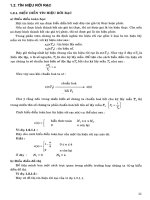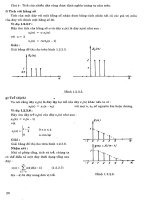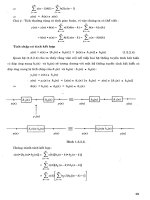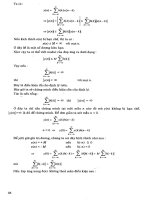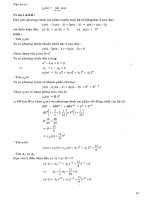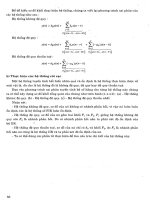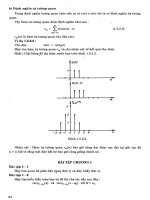0137027419XỬ LÝ TÍN HIỆU SỐ
Bạn đang xem bản rút gọn của tài liệu. Xem và tải ngay bản đầy đủ của tài liệu tại đây (984.89 KB, 81 trang )
Understanding Digital
Signal Processing
Third Edition
This page intentionally left blank
Understanding Digital
Signal Processing
Third Edition
Richard G. Lyons
Upper Saddle River, NJ • Boston • Indianapolis • San Francisco
New York • Toronto • Montreal • London • Munich • Paris • Madrid
Capetown • Sydney • Tokyo • Singapore • Mexico City
Many of the designations used by manufacturers and sellers to distinguish their products are claimed as trademarks. Where those designations appear in this book, and the publisher was aware of a trademark claim, the
designations have been printed with initial capital letters or in all capitals.
The author and publisher have taken care in the preparation of this book, but make no expressed or implied warranty of any kind and assume no responsibility for errors or omissions. No liability is assumed for incidental or consequential damages in connection with or arising out of the use of the information or programs contained herein.
The publisher offers excellent discounts on this book when ordered in quantity for bulk purchases or special
sales, which may include electronic versions and/or custom covers and content particular to your business,
training goals, marketing focus, and branding interests. For more information, please contact:
U.S. Corporate and Government Sales
(800) 382-3419
For sales outside the United States please contact:
International Sales
Visit us on the Web: informit.com/ph
Library of Congress Cataloging-in-Publication Data
Lyons, Richard G., 1948Understanding digital signal processing / Richard G. Lyons.—3rd ed.
p. cm.
Includes bibliographical references and index.
ISBN 0-13-702741-9 (hardcover : alk. paper)
1. Signal processing—Digital techniques. I. Title.
TK5102.9.L96 2011
621.382'2—dc22
2010035407
Copyright © 2011 Pearson Education, Inc.
All rights reserved. Printed in the United States of America. This publication is protected by copyright, and permission must be obtained from the publisher prior to any prohibited reproduction, storage in a retrieval system,
or transmission in any form or by any means, electronic, mechanical, photocopying, recording, or likewise. To
obtain permission to use material from this work, please submit a written request to Pearson Education, Inc.,
Permissions Department, One Lake Street Upper Saddle River, New Jersey 07458, or you may fax your request
to (201) 236-3290.
ISBN-13: 978-0-13-702741-5
ISBN-10:
0-13-702741-9
Text printed in the United States on recycled paper at Edwards Brothers in Ann Arbor, Michigan.
Fourth printing, August 2012
I dedicate this book to my daughters, Julie and Meredith—I wish I
could go with you; to my mother, Ruth, for making me finish my
homework; to my father, Grady, who didn’t know what he started
when he built that workbench in the basement; to my brother Ray
for improving us all; to my brother Ken who succeeded where I
failed; to my sister Nancy for running interference for us; and to the
skilled folks on the USENET newsgroup comp.dsp. They ask the good
questions and provide the best answers. Finally, to Sigi Pardula (Batgirl): Without your keeping the place running, this book wouldn’t
exist.
This page intentionally left blank
Contents
PREFACE xv
ABOUT THE AUTHOR
1
DISCRETE SEQUENCES AND SYSTEMS
1.1
1.2
1.3
1.4
1.5
1.6
1.7
1.8
2
18
33
Aliasing: Signal Ambiguity in the Frequency Domain
Sampling Lowpass Signals 38
Sampling Bandpass Signals 42
Practical Aspects of Bandpass Sampling 45
References 49
Chapter 2 Problems 50
THE DISCRETE FOURIER TRANSFORM
3.1
3.2
1
Discrete Sequences and Their Notation 2
Signal Amplitude, Magnitude, Power 8
Signal Processing Operational Symbols 10
Introduction to Discrete Linear Time-Invariant Systems 12
Discrete Linear Systems 12
Time-Invariant Systems 17
The Commutative Property of Linear Time-Invariant Systems
Analyzing Linear Time-Invariant Systems 19
References 21
Chapter 1 Problems 23
PERIODIC SAMPLING
2.1
2.2
2.3
2.4
3
xxiii
Understanding the DFT Equation
DFT Symmetry 73
33
59
60
vii
viii
Contents
3.3
3.4
3.5
3.6
3.7
3.8
3.9
3.10
3.11
3.12
3.13
3.14
4
THE FAST FOURIER TRANSFORM
4.1
4.2
4.3
4.4
4.5
4.6
5
DFT Linearity 75
DFT Magnitudes 75
DFT Frequency Axis 77
DFT Shifting Theorem 77
Inverse DFT 80
DFT Leakage 81
Windows 89
DFT Scalloping Loss 96
DFT Resolution, Zero Padding, and Frequency-Domain
Sampling 98
DFT Processing Gain 102
The DFT of Rectangular Functions 105
Interpreting the DFT Using the Discrete-Time
Fourier Transform 120
References 124
Chapter 3 Problems 125
135
Relationship of the FFT to the DFT 136
Hints on Using FFTs in Practice 137
Derivation of the Radix-2 FFT Algorithm 141
FFT Input/Output Data Index Bit Reversal 149
Radix-2 FFT Butterfly Structures 151
Alternate Single-Butterfly Structures 154
References 158
Chapter 4 Problems 160
FINITE IMPULSE RESPONSE FILTERS
5.1
5.2
5.3
5.4
5.5
5.6
5.7
5.8
5.9
169
An Introduction to Finite Impulse Response (FIR) Filters 170
Convolution in FIR Filters 175
Lowpass FIR Filter Design 186
Bandpass FIR Filter Design 201
Highpass FIR Filter Design 203
Parks-McClellan Exchange FIR Filter Design Method 204
Half-band FIR Filters 207
Phase Response of FIR Filters 209
A Generic Description of Discrete Convolution 214
Contents
ix
5.10
6
INFINITE IMPULSE RESPONSE FILTERS
6.1
6.2
6.3
6.4
6.5
6.6
6.7
6.8
6.9
6.10
6.11
6.12
6.13
7
253
An Introduction to Infinite Impulse Response Filters 254
The Laplace Transform 257
The z-Transform 270
Using the z-Transform to Analyze IIR Filters 274
Using Poles and Zeros to Analyze IIR Filters 282
Alternate IIR Filter Structures 289
Pitfalls in Building IIR Filters 292
Improving IIR Filters with Cascaded Structures 295
Scaling the Gain of IIR Filters 300
Impulse Invariance IIR Filter Design Method 303
Bilinear Transform IIR Filter Design Method 319
Optimized IIR Filter Design Method 330
A Brief Comparison of IIR and FIR Filters 332
References 333
Chapter 6 Problems 336
SPECIALIZED DIGITAL NETWORKS AND FILTERS
7.1
7.2
7.3
7.4
7.5
8
Analyzing FIR Filters 226
References 235
Chapter 5 Problems 238
Differentiators 361
Integrators 370
Matched Filters 376
Interpolated Lowpass FIR Filters 381
Frequency Sampling Filters: The Lost Art
References 426
Chapter 7 Problems 429
QUADRATURE SIGNALS
8.1
8.2
8.3
8.4
361
392
439
Why Care about Quadrature Signals? 440
The Notation of Complex Numbers 440
Representing Real Signals Using Complex Phasors
A Few Thoughts on Negative Frequency 450
446
x
Contents
8.5
8.6
8.7
8.8
8.9
9
THE DISCRETE HILBERT TRANSFORM
9.1
9.2
9.3
9.4
9.5
9.6
10
Quadrature Signals in the Frequency Domain 451
Bandpass Quadrature Signals in the Frequency Domain
Complex Down-Conversion 456
A Complex Down-Conversion Example 458
An Alternate Down-Conversion Method 462
References 464
Chapter 8 Problems 465
Hilbert Transform Definition 480
Why Care about the Hilbert Transform? 482
Impulse Response of a Hilbert Transformer 487
Designing a Discrete Hilbert Transformer 489
Time-Domain Analytic Signal Generation 495
Comparing Analytical Signal Generation Methods
References 498
Chapter 9 Problems 499
SAMPLE RATE CONVERSION
10.1
10.2
10.3
10.4
10.5
10.6
10.7
10.8
10.9
10.10
10.11
10.12
10.13
10.14
479
497
507
Decimation 508
Two-Stage Decimation 510
Properties of Downsampling 514
Interpolation 516
Properties of Interpolation 518
Combining Decimation and Interpolation 521
Polyphase Filters 522
Two-Stage Interpolation 528
z-Transform Analysis of Multirate Systems 533
Polyphase Filter Implementations 535
Sample Rate Conversion by Rational Factors 540
Sample Rate Conversion with Half-band Filters 543
Sample Rate Conversion with IFIR Filters 548
Cascaded Integrator-Comb Filters 550
References 566
Chapter 10 Problems 568
454
Contents
11
xi
SIGNAL AVERAGING
11.1
11.2
11.3
11.4
11.5
11.6
12
Coherent Averaging 590
Incoherent Averaging 597
Averaging Multiple Fast Fourier Transforms 600
Averaging Phase Angles 603
Filtering Aspects of Time-Domain Averaging 604
Exponential Averaging 608
References 615
Chapter 11 Problems 617
DIGITAL DATA FORMATS AND THEIR EFFECTS
12.1
12.2
12.3
12.4
12.5
13
589
Fixed-Point Binary Formats 623
Binary Number Precision and Dynamic Range 632
Effects of Finite Fixed-Point Binary Word Length 634
Floating-Point Binary Formats 652
Block Floating-Point Binary Format 658
References 658
Chapter 12 Problems 661
DIGITAL SIGNAL PROCESSING TRICKS
13.1
13.2
13.3
13.4
13.5
13.6
13.7
13.8
13.9
13.10
13.11
13.12
13.13
13.14
13.15
623
671
Frequency Translation without Multiplication 671
High-Speed Vector Magnitude Approximation 679
Frequency-Domain Windowing 683
Fast Multiplication of Complex Numbers 686
Efficiently Performing the FFT of Real Sequences 687
Computing the Inverse FFT Using the Forward FFT 699
Simplified FIR Filter Structure 702
Reducing A/D Converter Quantization Noise 704
A/D Converter Testing Techniques 709
Fast FIR Filtering Using the FFT 716
Generating Normally Distributed Random Data 722
Zero-Phase Filtering 725
Sharpened FIR Filters 726
Interpolating a Bandpass Signal 728
Spectral Peak Location Algorithm 730
xii
Contents
13.16
13.17
13.18
13.19
13.20
13.21
13.22
13.23
13.24
13.25
13.26
13.27
13.28
13.29
13.30
13.31
13.32
13.33
13.34
13.35
13.36
13.37
13.38
13.39
13.40
13.41
13.42
13.43
13.44
13.45
13.46
13.47
13.48
13.49
13.50
13.51
Computing FFT Twiddle Factors 734
Single Tone Detection 737
The Sliding DFT 741
The Zoom FFT 749
A Practical Spectrum Analyzer 753
An Efficient Arctangent Approximation 756
Frequency Demodulation Algorithms 758
DC Removal 761
Improving Traditional CIC Filters 765
Smoothing Impulsive Noise 770
Efficient Polynomial Evaluation 772
Designing Very High-Order FIR Filters 775
Time-Domain Interpolation Using the FFT 778
Frequency Translation Using Decimation 781
Automatic Gain Control (AGC) 783
Approximate Envelope Detection 784
A Quadrature Oscillator 786
Specialized Exponential Averaging 789
Filtering Narrowband Noise Using Filter Nulls 792
Efficient Computation of Signal Variance 797
Real-time Computation of Signal Averages and Variances 799
Building Hilbert Transformers from Half-band Filters 802
Complex Vector Rotation with Arctangents 805
An Efficient Differentiating Network 810
Linear-Phase DC-Removal Filter 812
Avoiding Overflow in Magnitude Computations 815
Efficient Linear Interpolation 815
Alternate Complex Down-conversion Schemes 816
Signal Transition Detection 820
Spectral Flipping around Signal Center Frequency 821
Computing Missing Signal Samples 823
Computing Large DFTs Using Small FFTs 826
Computing Filter Group Delay without Arctangents 830
Computing a Forward and Inverse FFT Using a Single FFT 831
Improved Narrowband Lowpass IIR Filters 833
A Stable Goertzel Algorithm 838
References 840
Contents
A
xiii
THE ARITHMETIC OF COMPLEX NUMBERS
A.1
A.2
A.3
A.4
847
Graphical Representation of Real and Complex Numbers 847
Arithmetic Representation of Complex Numbers 848
Arithmetic Operations of Complex Numbers 850
Some Practical Implications of Using Complex Numbers 856
B
CLOSED FORM OF A GEOMETRIC SERIES
C
TIME REVERSAL AND THE DFT
D
MEAN, VARIANCE, AND STANDARD DEVIATION
D.1
D.2
D.3
D.4
D.5
D.6
D.7
E
F
G
863
874
885
Using Logarithms to Determine Relative Signal Power
Some Useful Decibel Numbers 889
Absolute Power Using Decibels 891
DIGITAL FILTER TERMINOLOGY
893
FREQUENCY SAMPLING FILTER DERIVATIONS
G.1
G.2
G.3
G.4
867
Statistical Measures 867
Statistics of Short Sequences 870
Statistics of Summed Sequences 872
Standard Deviation (RMS) of a Continuous Sinewave
Estimating Signal-to-Noise Ratios 875
The Mean and Variance of Random Functions 879
The Normal Probability Density Function 882
DECIBELS (DB AND DBM)
E.1
E.2
E.3
859
903
Frequency Response of a Comb Filter 903
Single Complex FSF Frequency Response 904
Multisection Complex FSF Phase 905
Multisection Complex FSF Frequency Response
906
885
xiv
Contents
G.5
G.6
Real FSF Transfer Function 908
Type-IV FSF Frequency Response
910
H
FREQUENCY SAMPLING FILTER DESIGN TABLES
I
COMPUTING CHEBYSHEV WINDOW SEQUENCES
I.1
I.2
INDEX
931
913
927
Chebyshev Windows for FIR Filter Design 927
Chebyshev Windows for Spectrum Analysis 929
Preface
This book is an expansion of previous editions of Understanding Digital Signal
Processing. Like those earlier editions, its goals are (1) to help beginning students understand the theory of digital signal processing (DSP) and (2) to provide practical DSP information, not found in other books, to help working
engineers/scientists design and test their signal processing systems. Each
chapter of this book contains new information beyond that provided in earlier editions.
It’s traditional at this point in the preface of a DSP textbook for the author to tell readers why they should learn DSP. I don’t need to tell you how
important DSP is in our modern engineering world. You already know that.
I’ll just say that the future of electronics is DSP, and with this book you will
not be left behind.
FOR INSTRUCTORS
This third edition is appropriate as the text for a one- or two-semester undergraduate course in DSP. It follows the DSP material I cover in my corporate
training activities and a signal processing course I taught at the University of
California Santa Cruz Extension. To aid students in their efforts to learn DSP,
this third edition provides additional explanations and examples to increase
its tutorial value. To test a student’s understanding of the material, homework problems have been included at the end of each chapter. (For qualified
instructors, a Solutions Manual is available from Prentice Hall.)
xv
xvi
Preface
FOR PRACTICING ENGINEERS
To help working DSP engineers, the changes in this third edition include, but
are not limited to, the following:
• Practical guidance in building discrete differentiators, integrators, and
matched filters
• Descriptions of statistical measures of signals, variance reduction by
way of averaging, and techniques for computing real-world signal-tonoise ratios (SNRs)
• A significantly expanded chapter on sample rate conversion (multirate
systems) and its associated filtering
• Implementing fast convolution (FIR filtering in the frequency domain)
• IIR filter scaling
• Enhanced material covering techniques for analyzing the behavior and
performance of digital filters
• Expanded descriptions of industry-standard binary number formats
used in modern processing systems
• Numerous additions to the popular “Digital Signal Processing Tricks”
chapter
FOR STUDENTS
Learning the fundamentals, and how to speak the language, of digital signal
processing does not require profound analytical skills or an extensive background in mathematics. All you need is a little experience with elementary algebra, knowledge of what a sinewave is, this book, and enthusiasm. This may
sound hard to believe, particularly if you’ve just flipped through the pages of
this book and seen figures and equations that look rather complicated. The
content here, you say, looks suspiciously like material in technical journals
and textbooks whose meaning has eluded you in the past. Well, this is not just
another book on digital signal processing.
In this book I provide a gentle, but thorough, explanation of the theory
and practice of DSP. The text is not written so that you may understand the material, but so that you must understand the material. I’ve attempted to avoid the
traditional instructor–student relationship and have tried to make reading this
book seem like talking to a friend while walking in the park. I’ve used just
enough mathematics to help you develop a fundamental understanding of DSP
theory and have illustrated that theory with practical examples.
I have designed the homework problems to be more than mere exercises
that assign values to variables for the student to plug into some equation in
order to compute a result. Instead, the homework problems are designed to
Preface
xvii
be as educational as possible in the sense of expanding on and enabling further investigation of specific aspects of DSP topics covered in the text. Stated
differently, the homework problems are not designed to induce “death by algebra,” but rather to improve your understanding of DSP. Solving the problems helps you become proactive in your own DSP education instead of
merely being an inactive recipient of DSP information.
THE JOURNEY
Learning digital signal processing is not something you accomplish; it’s a
journey you take. When you gain an understanding of one topic, questions
arise that cause you to investigate some other facet of digital signal processing.† Armed with more knowledge, you’re likely to begin exploring further
aspects of digital signal processing much like those shown in the diagram on
page xviii. This book is your tour guide during the first steps of your journey.
You don’t need a computer to learn the material in this book, but it
would certainly help. DSP simulation software allows the beginner to verify
signal processing theory through the time-tested trial and error process.‡ In
particular, software routines that plot signal data, perform the fast Fourier
transforms, and analyze digital filters would be very useful.
As you go through the material in this book, don’t be discouraged if
your understanding comes slowly. As the Greek mathematician Menaechmus
curtly remarked to Alexander the Great, when asked for a quick explanation
of mathematics, “There is no royal road to mathematics.” Menaechmus was
confident in telling Alexander the only way to learn mathematics is through
careful study. The same applies to digital signal processing. Also, don’t worry
if you need to read some of the material twice. While the concepts in this
book are not as complicated as quantum physics, as mysterious as the lyrics
of the song “Louie Louie,” or as puzzling as the assembly instructions of a
metal shed, they can become a little involved. They deserve your thoughtful
attention. So, go slowly and read the material twice if necessary; you’ll be
glad you did. If you show persistence, to quote Susan B. Anthony, “Failure is
impossible.”
†“You
see I went on with this research just the way it led me. This is the only way I ever heard of
research going. I asked a question, devised some method of getting an answer, and got—a fresh
question. Was this possible, or that possible? You cannot imagine what this means to an investigator, what an intellectual passion grows upon him. You cannot imagine the strange colourless
delight of these intellectual desires” (Dr. Moreau—infamous physician and vivisectionist from
H.G. Wells’ Island of Dr. Moreau, 1896).
‡“One
must learn by doing the thing; for though you think you know it, you have no certainty
until you try it” (Sophocles, 496–406 B.C.).
xviii
Preface
Periodic
Sampling
How can the spectra of sampled
signals be analyzed?
How can the sample rates of
discrete signals be changed?
Window
Functions
How can DFT
measurement accuracy
be improved?
Discrete Fourier
Transform
How can digital filter
frequency responses
be improved?
How does
windowing
work?
How can
spectra be
modified?
Digital Filters
Why are discrete spectra
periodic, and what causes
DFT leakage?
What causes
passband ripple in
digital filters?
Convolution
How can spectral noise be reduced
to enhance signal detection?
How can the noise reduction
effects of averaging be improved?
Signal
Averaging
COMING ATTRACTIONS
Chapter 1 begins by establishing the notation used throughout the remainder
of the book. In that chapter we introduce the concept of discrete signal sequences, show how they relate to continuous signals, and illustrate how those
sequences can be depicted in both the time and frequency domains. In addition, Chapter 1 defines the operational symbols we’ll use to build our signal
processing system block diagrams. We conclude that chapter with a brief introduction to the idea of linear systems and see why linearity enables us to
use a number of powerful mathematical tools in our analysis.
Chapter 2 introduces the most frequently misunderstood process in digital signal processing, periodic sampling. Although the concept of sampling a
Preface
xix
continuous signal is not complicated, there are mathematical subtleties in the
process that require thoughtful attention. Beginning gradually with simple
examples of lowpass sampling, we then proceed to the interesting subject of
bandpass sampling. Chapter 2 explains and quantifies the frequency-domain
ambiguity (aliasing) associated with these important topics.
Chapter 3 is devoted to one of the foremost topics in digital signal processing, the discrete Fourier transform (DFT) used for spectrum analysis.
Coverage begins with detailed examples illustrating the important properties
of the DFT and how to interpret DFT spectral results, progresses to the topic
of windows used to reduce DFT leakage, and discusses the processing gain
afforded by the DFT. The chapter concludes with a detailed discussion of the
various forms of the transform of rectangular functions that the reader is
likely to encounter in the literature.
Chapter 4 covers the innovation that made the most profound impact on
the field of digital signal processing, the fast Fourier transform (FFT). There
we show the relationship of the popular radix 2 FFT to the DFT, quantify the
powerful processing advantages gained by using the FFT, demonstrate why
the FFT functions as it does, and present various FFT implementation structures. Chapter 4 also includes a list of recommendations to help the reader
use the FFT in practice.
Chapter 5 ushers in the subject of digital filtering. Beginning with a simple lowpass finite impulse response (FIR) filter example, we carefully
progress through the analysis of that filter’s frequency-domain magnitude
and phase response. Next, we learn how window functions affect, and can be
used to design, FIR filters. The methods for converting lowpass FIR filter designs to bandpass and highpass digital filters are presented, and the popular
Parks-McClellan (Remez) Exchange FIR filter design technique is introduced
and illustrated by example. In that chapter we acquaint the reader with, and
take the mystery out of, the process called convolution. Proceeding through
several simple convolution examples, we conclude Chapter 5 with a discussion of the powerful convolution theorem and show why it’s so useful as a
qualitative tool in understanding digital signal processing.
Chapter 6 is devoted to a second class of digital filters, infinite impulse
response (IIR) filters. In discussing several methods for the design of IIR filters, the reader is introduced to the powerful digital signal processing analysis tool called the z-transform. Because the z-transform is so closely related to
the continuous Laplace transform, Chapter 6 starts by gently guiding the
reader from the origin, through the properties, and on to the utility of the
Laplace transform in preparation for learning the z-transform. We’ll see how
IIR filters are designed and implemented, and why their performance is so
different from that of FIR filters. To indicate under what conditions these filters should be used, the chapter concludes with a qualitative comparison of
the key properties of FIR and IIR filters.
xx
Preface
Chapter 7 introduces specialized networks known as digital differentiators, integrators, and matched filters. In addition, this chapter covers two specialized digital filter types that have not received their deserved exposure in
traditional DSP textbooks. Called interpolated FIR and frequency sampling filters, providing improved lowpass filtering computational efficiency, they belong in our arsenal of filter design techniques. Although these are FIR filters,
their introduction is delayed to this chapter because familiarity with the
z-transform (in Chapter 6) makes the properties of these filters easier to understand.
Chapter 8 presents a detailed description of quadrature signals (also
called complex signals). Because quadrature signal theory has become so important in recent years, in both signal analysis and digital communications
implementations, it deserves its own chapter. Using three-dimensional illustrations, this chapter gives solid physical meaning to the mathematical notation, processing advantages, and use of quadrature signals. Special emphasis
is given to quadrature sampling (also called complex down-conversion).
Chapter 9 provides a mathematically gentle, but technically thorough,
description of the Hilbert transform—a process used to generate a quadrature
(complex) signal from a real signal. In this chapter we describe the properties,
behavior, and design of practical Hilbert transformers.
Chapter 10 presents an introduction to the fascinating and useful
process of sample rate conversion (changing the effective sample rate of discrete data sequences through decimation or interpolation). Sample rate conversion—so useful in improving the performance and reducing the
computational complexity of many signal processing operations—is essentially an exercise in lowpass filter design. As such, polyphase and cascaded
integrator-comb filters are described in detail in this chapter.
Chapter 11 covers the important topic of signal averaging. There we
learn how averaging increases the accuracy of signal measurement schemes
by reducing measurement background noise. This accuracy enhancement is
called processing gain, and the chapter shows how to predict the processing
gain associated with averaging signals in both the time and frequency domains. In addition, the key differences between coherent and incoherent averaging techniques are explained and demonstrated with examples. To
complete that chapter the popular scheme known as exponential averaging is
covered in some detail.
Chapter 12 presents an introduction to the various binary number formats the reader is likely to encounter in modern digital signal processing. We
establish the precision and dynamic range afforded by these formats along
with the inherent pitfalls associated with their use. Our exploration of the
critical subject of binary data word width (in bits) naturally leads to a discussion of the numerical resolution limitations of analog-to-digital (A/D) converters and how to determine the optimum A/D converter word size for a
Preface
xxi
given application. The problems of data value overflow roundoff errors are
covered along with a statistical introduction to the two most popular remedies for overflow, truncation and rounding. We end that chapter by covering
the interesting subject of floating-point binary formats that allow us to overcome most of the limitations induced by fixed-point binary formats, particularly in reducing the ill effects of data overflow.
Chapter 13 provides the literature’s most comprehensive collection of
tricks of the trade used by DSP professionals to make their processing algorithms more efficient. These techniques are compiled into a chapter at the end
of the book for two reasons. First, it seems wise to keep our collection of tricks
in one chapter so that we’ll know where to find them in the future. Second,
many of these clever schemes require an understanding of the material from
the previous chapters, making the last chapter an appropriate place to keep
our arsenal of clever tricks. Exploring these techniques in detail verifies and
reiterates many of the important ideas covered in previous chapters.
The appendices include a number of topics to help the beginner understand the nature and mathematics of digital signal processing. A comprehensive description of the arithmetic of complex numbers is covered in Appendix
A, and Appendix B derives the often used, but seldom explained, closed form
of a geometric series. The subtle aspects and two forms of time reversal in discrete systems (of which zero-phase digital filtering is an application) are explained in Appendix C. The statistical concepts of mean, variance, and
standard deviation are introduced and illustrated in Appendix D, and Appendix E provides a discussion of the origin and utility of the logarithmic
decibel scale used to improve the magnitude resolution of spectral representations. Appendix F, in a slightly different vein, provides a glossary of the terminology used in the field of digital filters. Appendices G and H provide
supplementary information for designing and analyzing specialized digital
filters. Appendix I explains the computation of Chebyshev window sequences.
ACKNOWLEDGMENTS
Much of the new material in this edition is a result of what I’ve learned from
those clever folk on the USENET newsgroup comp.dsp. (I could list a dozen
names, but in doing so I’d make 12 friends and 500 enemies.) So, I say thanks to
my DSP pals on comp.dsp for teaching me so much signal processing theory.
In addition to the reviewers of previous editions of this book, I thank
Randy Yates, Clay Turner, and Ryan Groulx for their time and efforts to help
me improve the content of this book. I am especially indebted to my eagleeyed mathematician friend Antoine Trux for his relentless hard work to both
enhance this DSP material and create a homework Solutions Manual.
xxii
Preface
As before, I thank my acquisitions editor, Bernard Goodwin, for his patience and guidance, and his skilled team of production people, project editor
Elizabeth Ryan in particular, at Prentice Hall.
If you’re still with me this far in this Preface, I end by saying I had a ball
writing this book and sincerely hope you benefit from reading it. If you have
any comments or suggestions regarding this material, or detect any errors no
matter how trivial, please send them to me at I promise I
will reply to your e-mail.
About the Author
Richard Lyons is a consulting systems engineer and lecturer with Besser Associates in
Mountain View, California. He has been the lead hardware engineer for numerous
signal processing systems for both the National Security Agency (NSA) and Northrop
Grumman Corp. Lyons has taught DSP at the University of California Santa Cruz Extension and authored numerous articles on DSP. As associate editor for the IEEE Signal Processing Magazine he created, edits, and contributes to the magazine’s “DSP Tips
& Tricks” column.
xxiii
This page intentionally left blank


